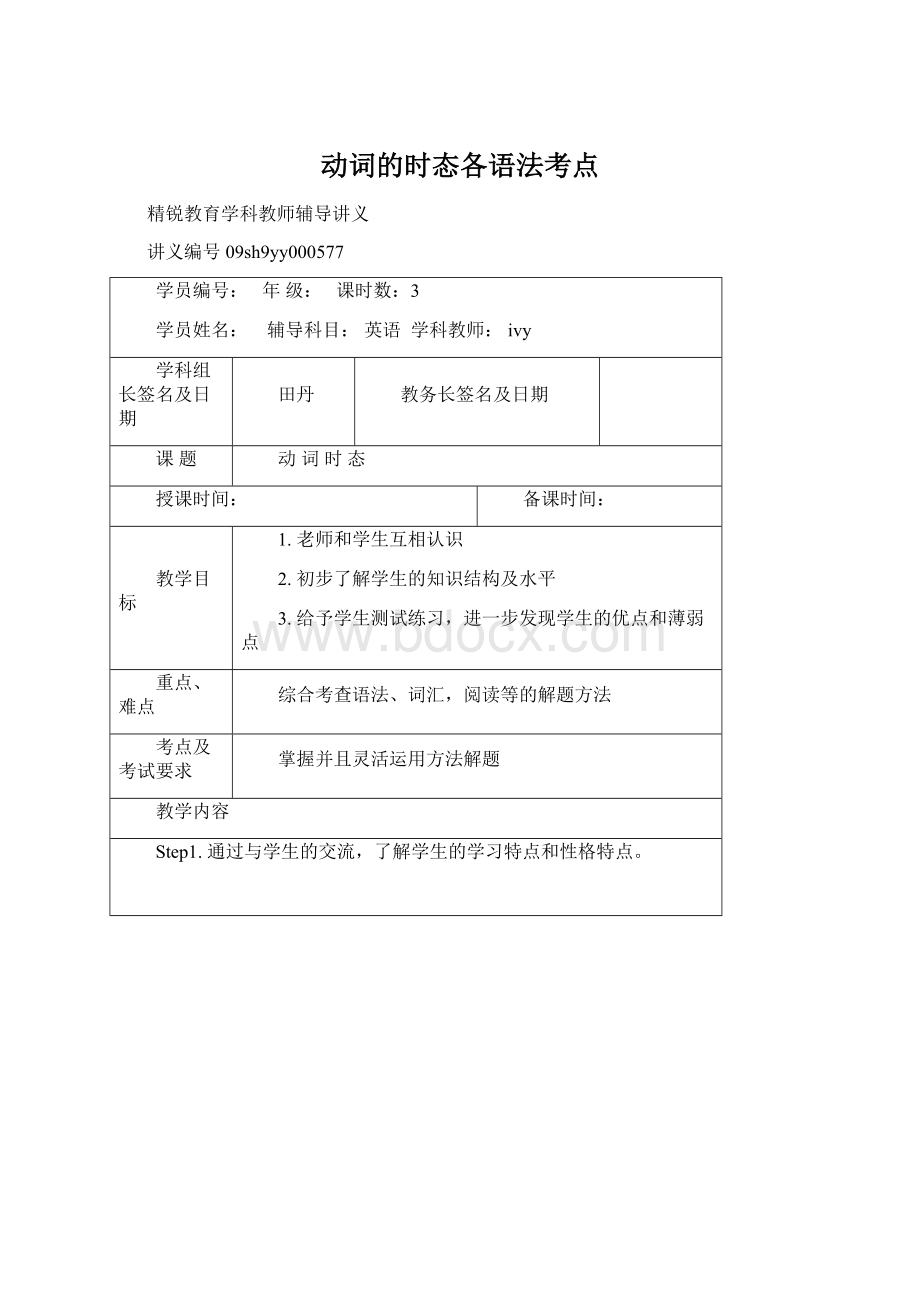动词的时态各语法考点.docx
《动词的时态各语法考点.docx》由会员分享,可在线阅读,更多相关《动词的时态各语法考点.docx(26页珍藏版)》请在冰豆网上搜索。

动词的时态各语法考点
精锐教育学科教师辅导讲义
讲义编号09sh9yy000577
学员编号:
年级:
课时数:
3
学员姓名:
辅导科目:
英语学科教师:
ivy
学科组长签名及日期
田丹
教务长签名及日期
课题
动词时态
授课时间:
备课时间:
教学目标
1.老师和学生互相认识
2.初步了解学生的知识结构及水平
3.给予学生测试练习,进一步发现学生的优点和薄弱点
重点、难点
综合考查语法、词汇,阅读等的解题方法
考点及考试要求
掌握并且灵活运用方法解题
教学内容
Step1.通过与学生的交流,了解学生的学习特点和性格特点。
Step2.做题,初步了解学生。
知识点列表
一、代词。
1.areveryclean.
A.Thewindow’sofourclassroomB.Thewindowsofourclassroom
C.Ourclassroom’swindowsD.Ourclassroomwindows’
2.----Whoseroomisthis?
----It’s.
A.myB.Kite’sandJohn’sC.ourD.MaryandJoan’s
3.ofmyparentsdrinksblackcoffee.
A.NoneB.NeitherC.AllD.Both
4.studentsareplayingontheplayground,andaretalkingwitheachother.
A.Some;otherB.Some;othersC.Part;othersD.Part;other
5.BothTomandMaryaregoingtovisitEgypt.(改为否定句)
TomnorMarygoingtovisitEgypt.
二、名词。
1.Pleasegiveonmywork.
A.someadviceB.someadvicesC.anadviceD.apieceadvice
2.Thegovernmenthasspentmoneyoneducation.
A.manyB.hugeamountofC.quiteafewD.hugeamountsof
3.Pleasebuyformymotherwhenyougoshopping.
A.fiveloavesofbreadB.fiveloafofbreadC.fiveloavesbreadD.fiveloavesofbreads
总结:
归纳本学期常见的不可数名词。
三、形容词或副词。
1.Thebookis,butIamnotinit.
A.interesting;interestedB.interested;interestingC.interested;interestedD.interesting;interesting
2.Ifyouare,you’dbettergotowork.
A.goodenoughB.enoughgoodC.wellenoughD.enoughwell
3.wearegoingtoseeanewfilm!
A.HowhappyB.WhathappyC.HowhappilyD.Whatahappily
4.TeddyBearslook.Mostofuslikethem.
A.nicelyB.wellC.beautifullyD.lovely
5.Inmountainareas,horsesarethancars.
A.muchmoreusefulB.farusefulC.evenuselessD.stilluseful
总结:
归纳形容词或副词的比较级和最高级的用法和结构。
四、动词。
(一)动词搭配
1.I’mtoobusymymotherherhousework.
A.tohelping;todoB.help;doC.tohelp;doD.tohelp;doing
2.Idon’tfeelliketomusic.Iwouldliketelevision.
A.tolisten;towatchB.listening;towatchC.tolisten;watchingD.listening;watching
3.Thefaithfuldogkeptafterthethiefuntilhewascaughtbythepoliceman.
A.chaseB.chasedC.tochaseD.chasing
4.Adamfortheexamination.Hehopestheuniversitythisautumn.
A.ispreparing;enteringB.prepares;toenterC.ispreparing;toenterD.prepares;entering
5.Ihateearlyinthemorning.
A.togetupB.gotupC.gettingupD.getup
总结:
归纳本学期常见动词的搭配(不定式、动名词或动词原形)。
实战演练:
1.Ourcountryalotsofar.Ihopeitwillbeeven.
A.haschanged;wellB.haschanged;betterC.changed;wellD.changed;better
2.----Howdeliciousthefoodis!
Whoit?
----Mary.Shebestinmyfamily.
A.cooks;does;cooksB.cooked;does;cooksC.cooks;did;cooksD.cooked;did;cooks
3.Wetheflowersinthegardenthistimeyesterday.
A.werewateringB.wateredC.hadwateredD.arewatering
4.HowlonghaveyoutheDVDplayer?
A.hadB.boughtC.borrowedD.lent
5.Theboywassoangrythathethedoorandout.
A.hadslammed;rushedB.slammed;rushedC.hadslammed;hadrushedD.slammed;hadrushed
五、宾语从句。
1.Couldyoutellme?
A.wherewasthenearestpostofficeB.whereisthenearestpostoffice
C.wherethenearestpostofficewasD.wherethenearestpostofficeis
2.Thelittleboywassofrightenedthathedidn’tknownext.
A.whathedoesB.whatshouldhedoC.whattodoD.howtodo
3.MissGaotoldusthatthesunintheeast.
A.riseB.risesC.roseD.risen
4.Shedoesn’tknowwhereshecanspendherholidayinsummer.(保持原句意思)
Shedoesn’tknowspendherholidayinsummer.
复习:
回顾宾语从句的三注意。
六、情态动词。
1.Theyhelpnow.Theycandoitthemselves.
A.needn’tanyB.don’tneedsomeC.don’tneedtosomeD.don’tneedany
2.Wehelptofightpollution.
A.mayB.shouldC.mustn’tD.needn’t
3.Studentswearschooluniformsinschool.
A.mayB.canC.shouldD.will
4.ThepricesoftheflatsinthehousingestatesinthecentreofShanghaibeveryhigh.
A.canB.mustC.shouldD.need
5.Asastudent,youought.
A.tonotbelateforschoolB.tofinishyourhomeworkontime
C.toberudetoothersD.tocopytheotherstudents’homework
总结:
归纳本学期情态动词的用法。
七、综合题。
(一)选择题。
1.----Ididn’tliketherecitationbyClass1.----.
A.SodidIB.NeitherdidIC.NeitherIdidD.SoIdid
2.Mrs.Zhou,togetherwithsomeguests,visitourschoolnextmonth.
A.aregoingtoB.isgoingtoC.willhaveD.weregoingto
3.wearetostaywithyou!
A.WhatahappyB.HowhappilyC.WhathappyD.Howhappy
注:
复习感叹句的结构。
4.Hewenttothestationwhenthetrainwasleaving.
A.findoutB.tofindoutC.tofindD.toknowabout
5.Timranasfastashecouldwintherace.
A./B.toC.sothatD.for
6.Thenumberofthestudents56.
A.isB.areC.hasD.have
7.ThereanEnglishlessontomorrowmorning.
A.isgoingtohaveB.isgoingtobeC.aregoingtohaveD.aregoingtobe
8.Theboy’slegbythedoctorlastweek.
A.isoperatedonB.isoperatedC.wasoperatedonD.wasoperated
9.You’dbettermakeyourself.
A.understandB.understoodC.understandingD.tounderstand
10.Readingnewspapersbecomeanimportantpartofourlife.
A.isB.areC.hasD.have
(二)按要求改写句子。
1.Mr.Smithwenttohisofficeinahurry.(保持原句意思不变)
Mr.Smithhisoffice.
2.Peopledidn’tusethemachineswidelyinthepast.(改为被动语态)
Themachineswidelyinthepast.
3.Carolwasaskedtomeetafriendofhermother’sattherailwaystation.(对划线部分提问)
wasCarolaskedtomeetattherailwaystation?
4.Timthoughtnoonedidasbadlyashiminthecontest.(保持原句意思)
Timthoughtheinthecontest.
Step3.动词时态
动词时态
英语动词时态用法
一般时态
进行时态
完成时态
完成进行时态
现在
过去
将来
过去将来
英语有十六个动词时态,在句子的谓语部分中体现。
现将初中段的八个时态简述如下:
Ⅰ.TheSimpleTenses一般时态
1)SimplePresent一般现在时
A)一般现在时用来表示经常性或习惯性的动作,目前的特征或状态,普遍真理等。
a)Istudyfortwohourseverynight.我每晚学习两小时。
b)Helookspale.他脸色苍白。
c)Waterconsistsofhydrogenandoxygen.水由氢和氧组成。
B)一般现在时主要由动词原形表示,但第三人称单数后要加词尾-s或-es,另外be和have有特殊的人称形式。
一般动词
动词tobe
动词tohave
Iknowit.
Youknowit.
He(She)knowsit.
We(You,They)knowit.
Iamadoctor.
Youareadoctor.
He(She)isadoctor.
We(You,They)aredoctors.
Ihaveapen.
Youhaveapen.
He(She)hasapen.
We(You,They)havepens.
C)一般现在时的疑问形式和否定形式
以like为例:
否定式
疑问式
构成方法
I
You
Wedon’tlikeit.
They
He
Shedoesn’tlikeit.
It
I
you
Dowelikeit?
they
he
Doesshelikeit?
it
加助动词do或does
以be为例:
否定式
疑问式
构成方法
Iamnotstrong.
He
Sheisnot(isn’t)strong.
It
We
Youarenot(aren’t)strong.
They
Am I strong?
he
Is shestrong?
it
we
Are youstrong?
they
否定式在am,is,are后加否定词not
疑问式将be动词放在句首
注意:
一般现在时表将来:
①下列动词:
come,go,arrive,leave,start,begin,return,live,fly的一般现在时表将来。
这主要用来表示在时间上已确定或安排好的事情。
Thetrainleavesatsixtomorrowmorning.
Whendoesthebusstart?
Itstartsintenminutes.
②倒装句,表示动作正在进行,如:
Herecomesthebus.=Thebusiscoming.
Theregoesthebell.=Thebellisringing.
③在时间或条件句中。
WhenBillcomes(不是willcome),askhimtowaitforme.
I'llwritetoyouassoonasIarrivethere.
④在动词hope,takecarethat,makesurethat等后。
Ihopetheyhaveanicetimenextweek.
Makesurethatthewindowsareclosedbeforeyouleavetheroom.
2)SimplePast一般过去时
A) 一般过去时用来表示过去某时刻或某段时间发生并结束的动作或存在的状态。
常与表示过去时间的状语连用。
a)Iboughtanewcarthreedaysago.我三天前买了一辆新车。
b)IlivedinParisfortenyears.我在巴黎住过十年。
B) 一般过去时由动词的过去式表示。
动词的过去式分规则与不规则两种形式。
不规则动词拼写特殊,只能逐个的记。
规则动词的过去式按以下规则加-ed构成:
构
例成
词
读音
加-ed
以-e结尾的加-d
辅音字母+y结尾的,先变y为i再加-ed
重读闭音节结尾,末尾仅有一个辅音字母的,双写这个辅音字母,再加-ed
元音和浊辅音后读[d]
stayed
smiled
saved
encouraged
carried
married
planned
清辅音后读[t]
Worked
hoped
---
stopped
辅音t和d后读[id]
needed
started
---
---
admitted
studded
C)一般过去时的疑问形式和否定形式:
以like为例:
否定式
疑问式
构成方法
I
You
He
Shedidn’t(didnot)likeit.
It
We
You
They
I
you
he
Did she likeit?
it
we
you
they
否定式在主语后加didnot
疑问式在句首加助动词did
以be为例:
否定式
疑问式
构成方法
I
He
Shewasnot(wasn’t)strong.
It
We
Youwerenot(weren’t)strong.
They
I
he
Wasshestrong?
it
we
Wereyoustrong?
they
否定式在was,were后加否定词not
疑问式将was,were放在句首
3)SimpleFuture一般将来时
A)一般将来时用来表示将要发生的动作或情况。
必须注意的是在时间或条件状语从句中,一般不能用将来时态,而用现在时态代替。
a)Hewillfinishhisworktomorrow. 他将在明天完成工作。
b)Assoonasthetaxiarrives,wewillbeabletoleavefortheairport.出租车一到我们就能前往机场。
B)一般将来时的构成:
shall/will+原形动词
肯定句
否定句
疑问句
I(We)shallgo.
He(She/It/You/They)willgo.
I(We)shallnotgo.
He(She/It/You/They)willnotgo.
ShallI(we)go?
Willhe(she/it/you/they)go?
注:
在口语中shall,will常缩合为’ll,与主语(人称代词)连写、连读。
如:
I’ll,You’ll,She’ll,willnot略写作won’t,shallnot略写作shan’t
E)begoingto+不定式也常用来表示将要发生的动作或情况(表示打算、准备做的事或即将发生或肯定要发生的事情)。
Eg.Thedoctorsaregoingtoperformanoperationtosavehislife.医生们将作手术以挽救他的生命。
4)PastFuture过去将来时
A) 过去将来时用来表示从过去某个时间看将要发生的事情。
这是一个相对概念的时态,立足于过去的一个特定时间来看未来。
b)Ithoughtyouwouldn’thaveanyproblem.我以为你不会有问题。
c)Hesaidhewouldraisethequestionatthemeeting.他说他要在会上提出这个问题。
B)过去将来时的构成:
should/would+动词原形
肯定
否定
疑问
I(We)shouldgo.
He(She/It/You/They)wouldgo.
I(We)shouldnotgo.
He(She/It/You/They)wouldnotgo.
ShouldI(we)go?
Wouldhe(she/it/you/they)go?
此外,一般过去将来时常可用来表示过去习惯性的动作(不管什么人称都用would)。
这时往往有一个时间状语,说明在什么情况往往如此。
如;Wheneverhehadtime,hewouldgoandtalkwithhispatients.他一有时间就去和病人交谈。
IIThePerfectTenses
1)PresentPerfect现在完成时
A)现在完成时表